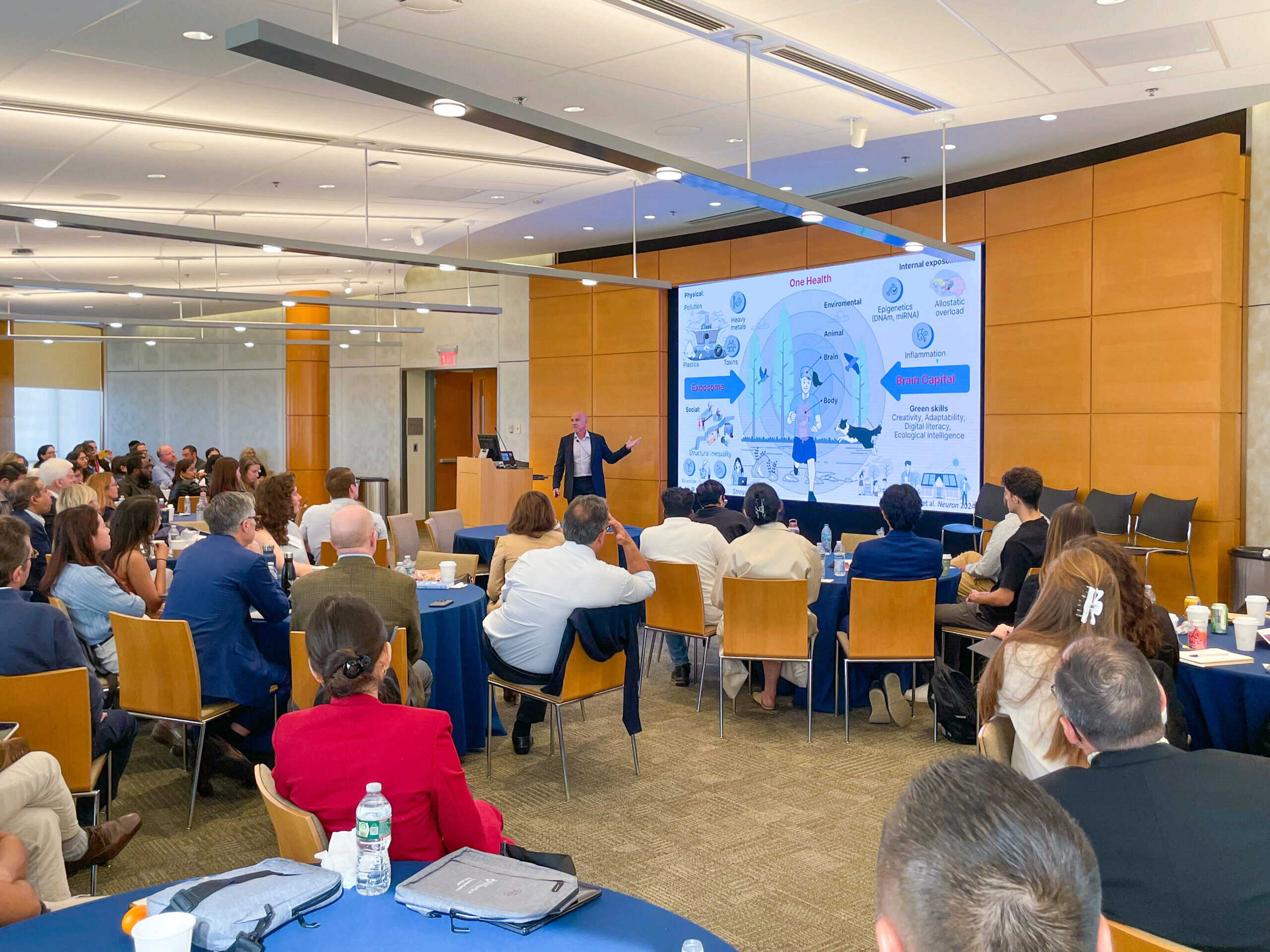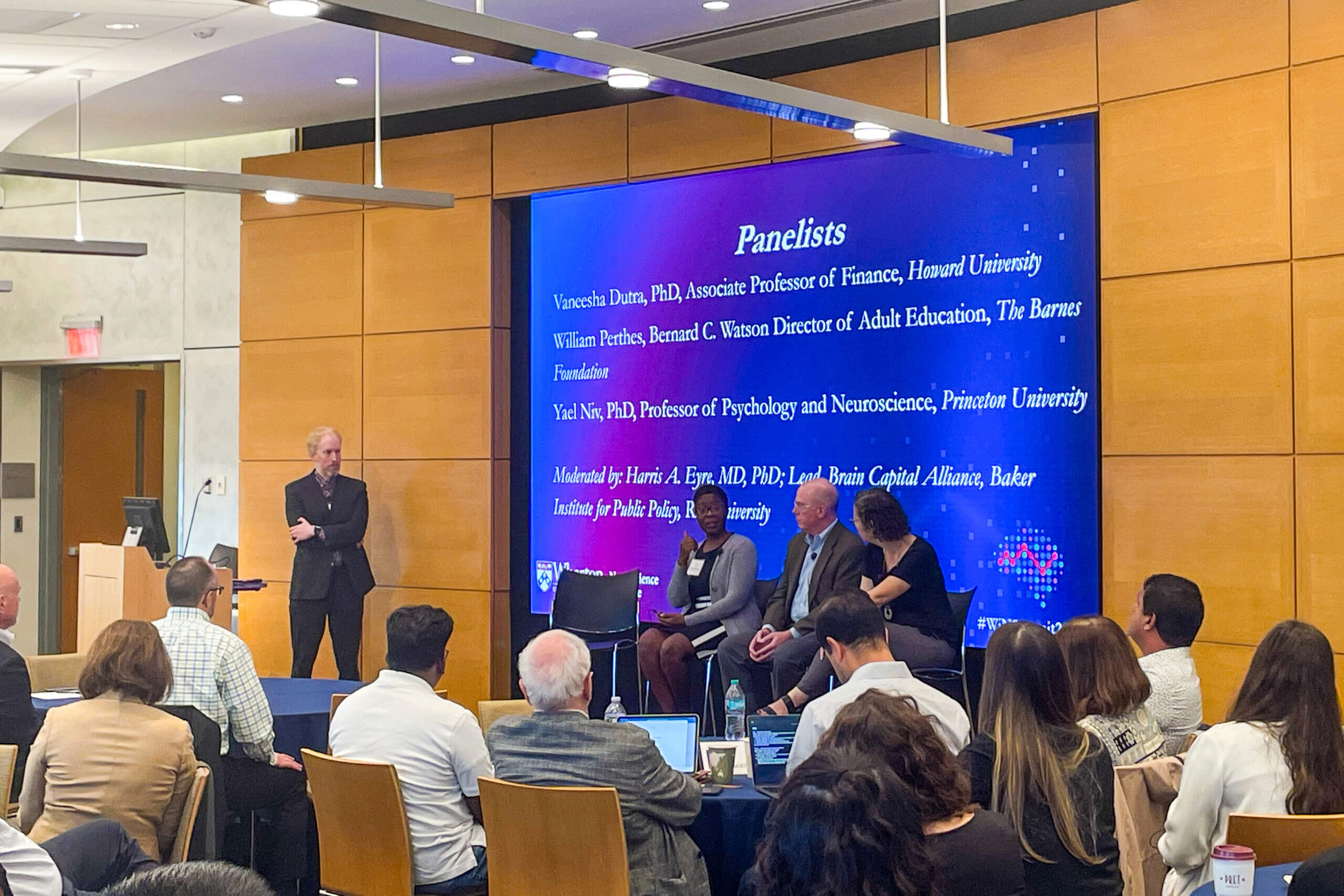Adaptation and Resilience in Business: The 2024 Wharton Neuroscience Summit

Wharton professor Michael Platt is using neuroscience to make the business case for better work culture.
During his keynote speech at the 2024 Wharton Neuroscience Summit, Platt shared charts, graphs, and illustrations to show what countless studies have revealed about resilience: People need a healthy dose of physical, mental, and emotional support to perform at their best. And they need real time off from work.
“Business leaders out there, why should you care? You should care deeply, and not just because it’s interesting, but because it matters for your bottom line,” Platt said to participants gathered in Huntsman Hall for the November 1st, 2024 summit, which was hosted by the Wharton Neuroscience Initiative (WiN).
Resilience was the theme of the daylong meetup. For his turn at the podium, Platt, who is faculty director at WiN, deftly combined anthropology, neuroscience, business, climate change, and monkeys into a 30-minute presentation titled, “When Disaster Strikes: Resilience in Context.”
Walking the audience through a brief history of human development, Platt explained why the brain isn’t wired for the modern world. It’s made for prehistoric times, when people lived in small, close-knit groups, spent most of their lives outside, got plenty of activity, and ate natural foods.
“Our brains are designed for an environment 200,000 years ago. And the way our brains, our bodies, our mental health, our well-being actually play out in the current environment reflects that,” he said.
“Our brains are designed for an environment 200,000 years ago. And the way our brains, our bodies, our mental health, our well-being actually play out in the current environment reflects that.”
Michael Platt, Faculty Director, Wharton Neuroscience Initiative
Man-made stressors are challenging enough, but natural disasters “turn up the volume knob” on trauma. For 30 years, Platt has been studying a colony of rhesus macaques that live freely on Cayo Santiago, an island off Puerto Rico. Their genetics, brains, and behaviors are very similar to humans, enabling scientists to collect a range of helpful data.
The monkeys were thriving until Hurricane Maria hit as a Category 5 hurricane in 2017, killing more than 3,000 people. None of the animals perished in the storm, but the physical and emotional toll triggered premature aging that was measurable.
“The molecular landscape of their bodies is changing. This is a function of stress,” Platt explained.
Some of the monkeys fared better than others, which made scientists interested in the root cause of their resilience. They discovered that the monkeys that thrived forged deeper social bonds and were more cooperative in the face of disaster. They became friendlier, nicer, and more tolerant. Those parts of their brains even grew bigger.
Humans can change their behavior to do the same, Platt said. To prove his point, he shared a Microsoft Labs survey that found companies with the highest employee engagement have leaders who invest in resilient cultures that support workers.
In his final message to business leaders, Platt offered a finding from a research paper he co-authored on deaths from the “epidemic of despair” in the U.S. The biggest difference between the U.S. and other industrialized countries is a dearth of paid time off.
“Time off is necessary, not just to rest but also to reconnect with your families, your friends, to engage in play, to make music, to be joyful. That’s part of the human toolkit,” he said. “And look, we just ain’t doing it, so we have to do better.”

Building Resilience for a Better Life
There’s a U-shaped curve to happiness that bottoms out in middle age, which happens to be around the same time many people become managers or leaders. In addition to taking care of their teams at work and their families at home, they also need to take care of themselves.
“Life is pulling at us in a lot of different ways, but we know it’s going to get better. How do we have the tools to handle this [low point] so we get to enjoy those next few decades?” Jen Wagner said during her presentation, “Resilience: The Pathway to High(er) Performance.”
Wagner is a physician, athlete, and performance expert who co-founded Prosper, a consultancy that harnesses science to help with behavioral change. During her keynote speech at the WiN summit, she shared the Resilience Matrix. It’s a chart of the four building blocks for a more resilient life: mindset, recovery, fuel, and movement.
“It is going back to basics. It is how we take care of ourselves day in and day out,” she said. “What decision can I make at 6 a.m. that’s going to make my 6 p.m. better? And what habits can I start to incorporate into my life?”
Wagner advocated for small behavioral changes that compound over time – a neuroscientific approach — rather than big changes that are hard to stick with. It can be as small as taking “exercise snacks” through the day to increase movement or not using a cellphone for the first 30 minutes after waking up. On her recent travels, she found herself staring at the array of processed foods in the airport gift shop and deliberately chose a bag of pistachios instead.
“It’s a culture shift in my head. It’s different than what society has told me my entire life. And it’s a small thing, but it’s leading to big results,” Wagner said.
Cultivating a mindset of gratitude, getting enough quality sleep, eating nourishing foods, and exercising are the four components of the matrix. But Wagner said equally important is maintaining positive social bonds with supportive people.
“As leaders, we have to model this for those who are underneath us, especially the younger generation that has grown up in this digital age and are very isolated,” she said. “We have to model how to connect with each other, how to take care of ourselves, how to put our oxygen masks on first, so we can not only stay in our leadership positions, but thrive in them.”

“It is going back to basics. It is how we take care of ourselves day in and day out. What decision can I make at 6 a.m. that’s going to make my 6 p.m. better? And what habits can I start to incorporate into my life?”
Jen Wagner, CEO, Prosper
How Neuroscience Can Help Societal Problems
Women entrepreneurs receive less than 2% of venture capital funding, a number that hasn’t budged in decades. But neuroscience may improve the odds for women and minority founders pitching their business plans to investors who are overwhelmingly white and male.
That’s what Howard University finance professor Vaneesha Dutra is studying with Michael Platt, faculty director of the Wharton Neuroscience Initiative. They’re figuring out how minority female founders can change their communication to pitch more effectively to VCs who don’t come from their same communities or share their same perspectives. They’re also using neuroscience to change how VCs receive the pitch.
“We know there’s systemic bias, but there has to be something more,” Dutra said. “Through this science, we’re able to understand the synchronicity, we’re able to understand the timing of the pitch.”
Dutra was part of a panel discussion that also featured William (Bill) Perthes, director of adult education at The Barnes Foundation, and Yael Niv, psychology and neuroscience professor at Princeton University. The panelists, each with different specialties, talked about some of the unexpected ways that neuroscience is helping to solve problems traditionally thought of as the domain of other disciplines.
Mental health conditions are an example, Niv said. Clinicians of the past relied mostly on an understanding of genetics and medication to treat their patients; now they know that neuroscience is also part of managing disease.

“I’ve really learned that behavior can teach us about the brain much more than the brain can teach us about the brain,” said Niv, who also served as a keynote speaker at the summit. “The brain is so complex, and we’re not anywhere close to understanding exactly how it works. You can find anything there.”
At the Barnes Foundation in Philadelphia, Perthes and his colleagues apply neuroscience to connect the ethereal beauty of art with daily life. The foundation houses a world-class collection of impressionist, post-impressionist, and modern art – pieces that evoke a range of responses in the brain. Perthes works with groups as diverse as FBI agents, health care professionals, and formerly incarcerated citizens to help them develop critical skills through the observation of art. Closely examining the details of a painting, for example, can strengthen a doctor’s diagnosis ability or teach an FBI agent to look beyond the surface. Talking through the complexities of a piece can help a returning citizen develop better communication skills for a job interview.
“It gives them an analytical approach that can be applicable not only to any kind of art, but it really connects to lived experiences. And that’s the most essential thing,” Perthes said. “A lot of it centers around our observation skills.”


